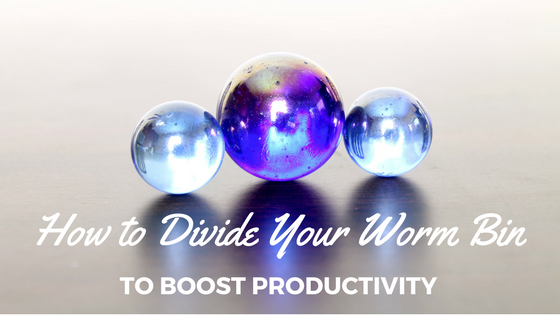Have you heard the big news? There’s gold in them thar hills! Black gold!
You needn’t pan for gold to find the value in raising compost worms. Black gold isn’t off in some distant land; it’s yours for the making right at home!
Wouldn’t you love to score heaps of all a worm bin has to offer? We both know full well the squirming contents of a worm bin can quickly generate a very impressive amount of both new worms and rich castings. But heaps?
Worm Herd Starter Fund
Your worm bin is a lot like that first $20 you put into the bank as a kid. As time passed, that money gained interest and grew continually. Eventually, you found your investment returned way more than the $20 you started with. Cool!
In much the same way, your herd of worms is about to gain you some real compound interest!
Today you will learn just how very easy it is to divide and add worm bins to greatly boost productivity. I did it–you can too!
Why Did I Decide to Split My Bins?
I realized that I had never once thought, boy, I wish I had less of this awesome fertilizer, or, hm, if only these worms would consume a lot less of my leftover food scraps and shredded cardboard. No way! In fact, I wanted more of it, so I decided to add to my luxury worm apartment (Worm Factory 360) and Hotel de Worms (Rubbermaid tote).
Your reasons to incorporate more area for worm composting could be as simple as ensuring the health of your worms, or as practical as for bottom line business purposes. Really, any rationale for multiplying your worm herd is a valid one.
Is it Time Yet to Split Your Bin?
You may be ready to take your worm composting hobby to the next level by adding worm real estate, but are your worms ready too?
- Only split a mature vermicompost system.
- Only use healthy bedding and thriving worms to start new bins.
- Only add worms to bins prepared with moist bedding and starter materials.
On average, it takes 4-6 months for vermicompost to become fully processed, or complete. Finished worm compost should be mostly dark and fine, and should have no foul odors or remaining food scraps.
Is it time yet?
At the end of 4-6 months, the population of worms should have doubled and become large enough to divide easily. Great news! And what’s more, healthy red wigglers are fairly resilient to being handled for a division. They should be expected to give little, if any, negative feedback. Ha!
Is it time yet?
Make Room for Your Worms to Grow
Moist new bedding mixed with starter worms and vermicompost teeming with microbes can become that bank account with the high-yield interest. In a new open space worms instinctively sense the opportunity to populate and begin to reproduce like they are on a mission.
For every square foot of surface area you add, an additional 1,000 worms can squirm into your worm compost production. That means a well-maintained full stack of Worm Factory 360 trays can hold as many as 10,000 worms or more!
So many pounds of worms hold immeasurable potential. How will you use yours?
New Home to Roam
Unless you are doing a science experiment with your onward moving Eisenia fetida, you don’t need to measure a thing for these next few steps.
- Prepare new living quarters with moist bedding materials.
- Gently scoop up masses of worms in vermicompost.
- Add to the new bins.
That’s it. At least if you want it to be that easy. And it can be. I just added two more bins and a big plastic pot using this method.
I just opened up my “starter bin” and doled out scoops of worms and rich compost. Each of the three new worm homes was layered with:
- moist shredded paper
- crumbled leaves from my compost pile
- scoops of populated vermicompost
- pureed food
I gently turned the layers to ensure even moisture throughout and let the worms be.
When I checked on them today, they were all alive and well in their new homes, eating and crawling around. I watered them a bit and tucked them back into the shade of my wooden bench. In a few weeks, things should be moving along at a pretty fast clip.
I’m so excited to start fresh again! It’s been so long since I began…
Not Quite an Empty Nest
My “starter bin” is now in a good position to grow quickly once again because the population has decreased. And there is even a surefire way to make it BOOM!
Harvest out a majority of the remaining finished compost. The mass of worms will wriggle themselves into a breeding frenzy. Add easily consumable feed, fresh moist bedding, and just give them time.
Make It Happen
See how easy it is to split a bin? Soon YOU’LL have more worms, more fertilizer, less trash, and a real boost in the value of YOUR herd. Yes, you can! Add a Worm Factory 360 for up to 7.5 more square feet of space all on an 18” footprint!
Insider’s Tip:
Did you know that the ratio to aim for is about 2 parts brown to 1 part green?
For a long time, I focused on feeding my worms a “healthy” diet of fruits and vegetables; I completely overlooked the seemingly endless resource of junk mail and cardboard boxes that find their way into my house.
Soaked in non-chlorinated water, shredded cardboard is a great edible bedding for your compost worm herd. As red wigglers build their new colonies, this brown material will not only feed your worms well but also give them new space to occupy.
It’s easy to quickly bulk up the volume of compostables in your Worm Factory 360 trays by adding layers of moist shredded cardboard over feedings of green. The worms will love it and quickly process it into fresh fertilizer while growing the population and boosting overall production.
If you are ready to add on and need some space, try a Worm Factory 360 to transform the greatest volume of waste in the smallest amount of space.
Happy worm composting!
Questions, Comments, or Concerns?
If you need any help, we’re always here for you..


could you please change my email address to joern@entrepreneur-sme.asia -somehow my signup for neSsletter was joern@ENTREPRENEUR-SME.US – THAT’S WRONG – THANKS
Joern- The easiest way to make this switch is to unsubscribe anytime from the link you find at the bottom of your monthly newsletter. We’d hate to lose you, so make sure to simply resubscribe using your preferred email address.
4 to six months? It is completely wrong, it has many factors. The kind of worm and their environment. In my case I had to split mine withing a month and half. They were reproducing faster than average.